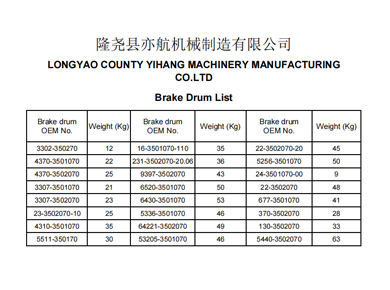10 月 . 17, 2024 08:31 Back to list
Steps to Successfully Replace Your Vehicle's Brake Drums for Improved Performance
How to Change Brake Drums A Step-by-Step Guide
Changing brake drums is an essential aspect of vehicle maintenance that ensures safety and optimal performance of your car. Over time, brake drums can wear out, leading to reduced braking efficiency and potential safety hazards. This guide will walk you through the process of changing brake drums, providing you with the necessary steps and tips for a successful job.
Tools and Materials Needed
Before you begin, it’s important to gather the right tools and materials. Here’s what you will need
- New brake drums - Brake shoes (if necessary) - Brake cleaner - Socket set - Wrenches - Screwdrivers - Jack and jack stands - Tire iron - Torque wrench - Safety goggles - Gloves
Step 1 Prepare Your Vehicle
1. Safety First Always wear safety goggles and gloves when working on your vehicle. 2. Park on a Flat Surface Ensure your vehicle is on a level surface to prevent rolling.
3. Loosen Lug Nuts Using a tire iron, slightly loosen the lug nuts on the wheel covering the brake drum you intend to change. Do not remove them completely yet.
4. Lift the Vehicle Use a jack to lift the vehicle off the ground. Once elevated, place jack stands beneath the vehicle to ensure it is secure.
Step 2 Remove the Wheel
1. Take Off the Wheel Remove the lug nuts completely and take the wheel off to expose the brake drum.
Step 3 Remove the Brake Drum
1. Inspect the Brake Drum Before removal, check for signs of wear and damage.
2. Remove the Brake Drum If the drum is stuck, gently tap it with a hammer to loosen it. If it doesn’t budge, inspect for retaining screws that may need to be removed.
how to change brake drums

Step 4 Install New Brake Drums
1. Clean the Area Before installing new brake drums, clean the spindle and the area where the drum sits using brake cleaner to remove any dust or debris.
2. Install New Brake Shoes (if applicable) Follow the manufacturer’s instructions to install new brake shoes on the backing plate.
3. Install the New Drum Slide the new brake drum onto the hub. Ensure it is seated properly.
Step 5 Reassemble and Test
1. Reattach the Wheel Place the wheel back onto the hub and hand-tighten the lug nuts.
2. Lower the Vehicle Carefully remove the jack stands and lower the vehicle back to the ground.
3. Tighten Lug Nuts Use a torque wrench to tighten the lug nuts to the manufacturer’s specifications.
Step 6 Final Checks
1. Pump the Brakes Before you drive the vehicle, pump the brake pedal a few times to ensure that the brake shoes are seated properly against the drum.
2. Test Drive Go for a short test drive in a safe, controlled environment to make sure everything is functioning properly. Pay attention to any unusual noises or brake feel.
Conclusion
Changing brake drums may seem daunting at first, but with the right tools, instructions, and a methodical approach, it is a manageable DIY task that can save you money and enhance your vehicle’s performance. Always take safety precautions, and don’t hesitate to consult a professional if you encounter any issues or if you’re unsure about any part of the process. Proper maintenance of your braking system is crucial for your safety on the road, so make it a routine part of your vehicle care. Remember, a well-maintained brake system is key to a safe driving experience.
-
Brake Drum for Kamaz Trucks Durable OEM Replacement & High Performance
NewsMay.30,2025
-
Brake Drum Man High-Quality Drum Brake & Shoe Solutions
NewsMay.30,2025
-
High-Performance Brake Drum for Kamaz Trucks Durable Drum Brake Components
NewsMay.29,2025
-
Brake Drum Man High-Quality Drum Brake Drums & Brake Shoes
NewsMay.29,2025
-
Brake Drum MAZ High-Performance & Durable Replacement Parts
NewsMay.29,2025
-
heavy truck brake drums
NewsMar.07,2025
